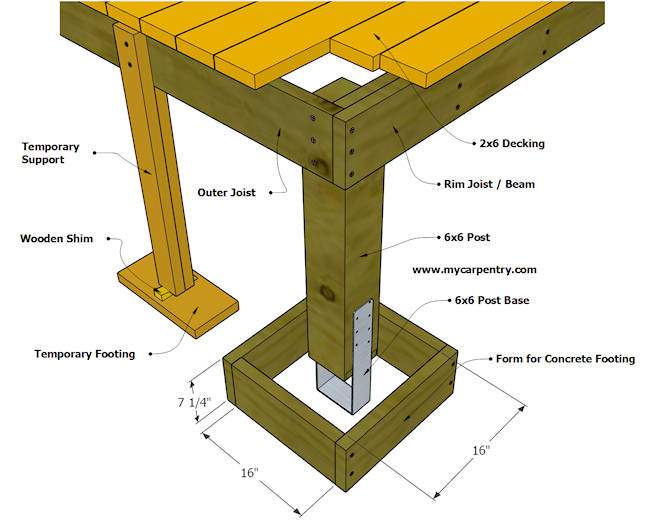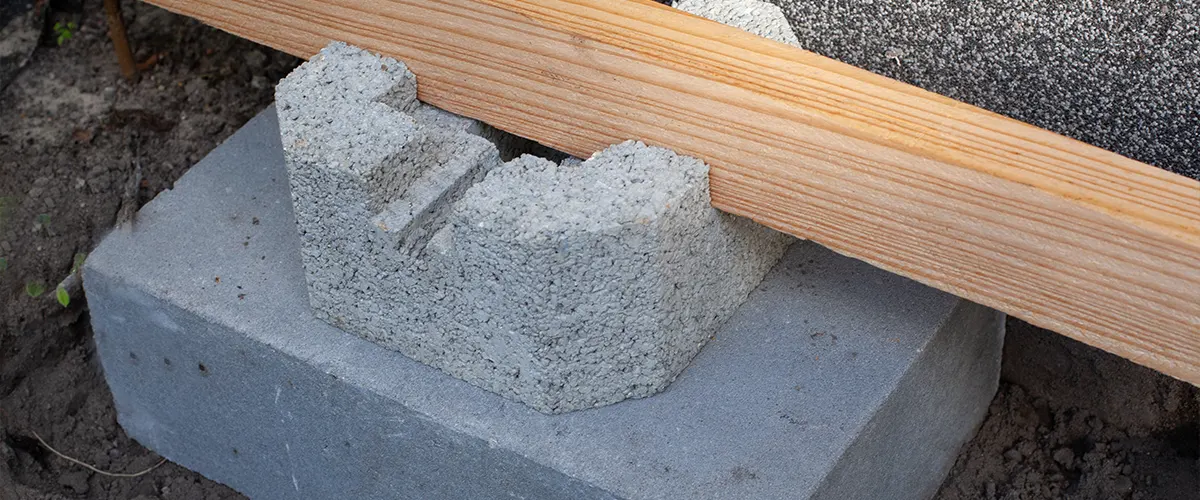Solid Foundations, Gorgeous Decks: The Ultimate Guide to Deck Footings
Wiki Article
Essential Tips for Solid Deck Ground: A Comprehensive Overview
Welcome to "Essential Tips for Solid Deck Ground: A Comprehensive Overview." In this detailed guide, we will provide you with the important knowledge and approaches to make certain a solid and secure foundation for your deck. Developing a deck is an investment that requires mindful preparation and interest to detail, specifically when it involves the ground. This guide will cover vital elements such as selecting the right products, evaluating soil problems, determining load capacity, figuring out proper ground depth, and achieving specific setup. By following these ideas, you will be equipped with the needed information to construct a deck that not only boosts your outside room however likewise stands the test of time. Let's dive into the globe of solid deck footing and develop a foundation you can count on.Selecting the Right Deck Ground Products
When picking the best deck footing products, it is vital to think about the details needs and needs of your task. The quality and toughness of the footings directly affect the security and longevity of the deck structure. When choosing deck footing materials., there are a number of aspects to think about.One vital factor to consider is the sort of soil in your area. Different soil kinds have differing load-bearing abilities and water drainage properties. Clay dirts have a tendency to maintain water, while sandy soils drain rapidly. Recognizing your dirt problems will certainly assist you select footings that can efficiently support the weight of the deck and prevent problems such as sinking or heaving.
Extreme temperature levels, wetness degrees, and freeze-thaw cycles can impact the efficiency of deck footings. In such instances, utilizing frost-resistant products or setting up grounds below the frost line can aid alleviate these risks.
Furthermore, the dimension and style of your deck must likewise affect your choice of footing products. Larger or more complicated decks might need deeper or reinforced grounds to ensure appropriate support. Comprehending the specific tons needs of your deck will aid you figure out the appropriate materials to utilize.
Ultimately, choosing the appropriate deck footing materials includes careful factor to consider of factors such as soil problems, environment, and deck design. By taking these elements right into account, you can pick footings that offer the necessary support, improve the security of your deck, and guarantee its longevity.
Correctly Examining Dirt Problems
To properly analyze soil conditions for your deck footing, it is crucial to thoroughly evaluate the load-bearing capabilities and water drainage homes of the dirt in your location. Understanding the soil's capability to bear weight and its capability to drain pipes excess water will certainly assist make sure the security and long life of your deck.When assessing the load-bearing capability of the soil, it is very important to think about aspects such as dirt density, compaction, and kind. Various soil types have varying load-bearing capabilities, with compacted dirts generally using much better support than loosened or sandy soils. Conducting a dirt examination can supply useful info regarding the soil's capability to support the weight of your deck.
Furthermore, assessing the drain residential or commercial properties of the soil is necessary to protect against water buildup and possible damages to your deck - Deck Footings. Poor drain can lead to moisture build-up, which can deteriorate the structure and trigger structural concerns. It is essential to assess the soil's capacity to drain water effectively to stay clear of these issues
Consulting with a professional designer or soil specialist can substantially help in correctly assessing dirt conditions for your deck ground. They can offer experienced guidance and guidance, making sure that you choose the suitable ground style and products based on the details attributes of the dirt in your area. Putting in the time to completely evaluate dirt conditions will certainly help you construct a solid and long lasting deck.
Computing Tons Capability for Footings
One important action in making sure the security of your deck is to precisely calculate the load capability for your grounds. Deck Footings. The tons capacity refers to the optimum quantity of weight or load that the footings can securely sustain without causing any type of architectural damage or failing. Calculating the load capability for grounds entails considering various aspects such as the dimension and sort of footings, the kind of soil, the dimensions and weight of the deck, and the online tons and dead lots that the deck will certainly undergoTo calculate the load capacity, it is essential to consult local building ordinance and guidelines as they supply details standards and requirements for deck construction. These codes consider elements such as dirt bearing capability, frost deepness, and minimal ground measurements. Furthermore, it is critical to involve the solutions of an architectural engineer or a specialist service provider that can carry out the required estimations and assessments to make certain the safety and security and security of the deck.
When computing the load capacity, it is necessary to properly determine the real-time lots and dead lots that the deck will experience. The live load describes the weight of individuals, furniture, and any various other items that will certainly be positioned on the deck, while the dead tons refers to the weight of the deck itself. By accurately determining these lots and taking into consideration all appropriate elements, you can ensure that your grounds are adequately made to sustain the weight and preserve the security of your deck.
Making Certain Appropriate Footing Deepness
Appropriate footing deepness is important for guaranteeing the security and durability of your deck. The depth at which the grounds are set up straight impacts the structural stability of the deck, as it identifies how well the grounds can resist the pressures exerted by the deck and the dirt below it.When determining the ideal footing deepness, a number of factors need to be considered. These consist of the type of dirt, the local environment, and the load capability needed for the deck. Normally, footings must be placed below the frost line to protect against any type of heaving or changing due to cold and thawing cycles. In areas with extensive clay dirt, deeper grounds might be needed to give sufficient assistance.
To determine the appropriate ground depth, it is advised to seek advice from a structural engineer or building examiner that can assess the particular conditions of your website and give guidance based on local building ordinance and guidelines. They will certainly take into consideration factors such as soil structure, groundwater level degree, and anticipated lots to establish the minimum her explanation required ground depth.
Installing Footings With Precision
Installing grounds with accuracy is necessary for making certain the security and structural integrity of your deck. Effectively installed grounds give a strong foundation, guaranteeing that your deck can withstand the weight of furnishings, individuals, and other loads. To mount grounds with precision, there are several vital actions to comply with.Firstly, it is very important to properly note the location of each ground. This can be done by utilizing a string or chalk line to produce a clear overview. By measuring and noting the precise positions, you can make certain that the footings are evenly spaced and straightened.
Next, you require to dig the holes for the footings. It is vital to dig them to the right depth and size, as specified by neighborhood building regulations and laws. This will provide appropriate support and protect against the deck from sinking or moving with time.
When the openings are dug, it is necessary to level and small the dirt at the bottom site of each opening. This will develop a secure base for the footing to remain on and stop any kind of settling or activity.
After preparing the holes, you can continue with pouring the concrete. Make use of a concrete mix that is suitable for footings and comply with the supplier's directions for blending and putting. Guarantee that the concrete fills up the openings completely and is degree with the ground surface.
Finally, permit the concrete to cure appropriately prior to waging the building and construction of your deck. This will make sure that the grounds are strong and stable, providing a protected structure for your deck.

Conclusion
To conclude, ensuring strong deck ground is important for the security and durability of a deck structure. By choosing the appropriate ground products, examining soil conditions, computing lots capability, and setting up footings with precision, the threat of architectural failure can be minimized. Adhering to these crucial pointers will certainly help develop a solid structure for any kind of deck task.Comprehending your soil problems will help you pick footings that can effectively sustain the weight of the deck and stop issues such as heaving or sinking.
Consulting with an expert engineer or dirt specialist can considerably assist in effectively examining soil problems for your deck footing. Computing the tons ability for footings involves taking into consideration different variables such as the size and kind of footings, the kind of soil, the measurements and weight of the deck, and the live lots and dead load that the deck will certainly be subjected to.

Report this wiki page